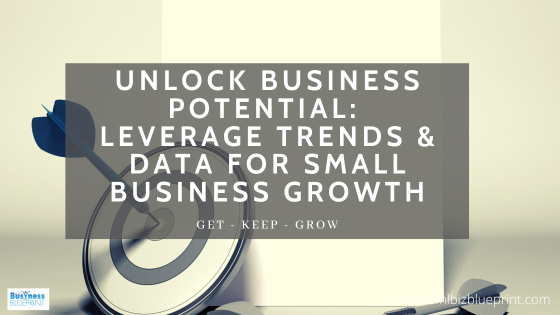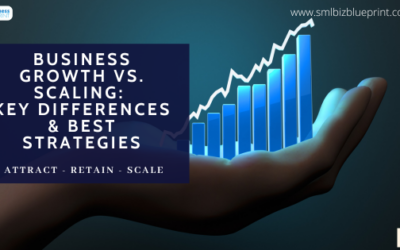As a small to medium-sized business owner, you understand the importance of staying ahead of the curve and making informed decisions.
In today’s rapidly evolving business landscape, leveraging trends and data is crucial to unlocking your business’s full potential.

In this comprehensive guide, we will explore actionable strategies to help you harness the power of trends and data, enabling you to drive growth, enhance customer experiences, and achieve long-term success.
Understanding Current Market Trends
Keeping a pulse on current market trends is essential to maximise your business potential.
Identify emerging opportunities that align with your business goals and tap into untapped markets. Whether it’s the rising demand for sustainable products or the growing interest in digital health solutions, staying updated on trends allows you to position your business for success.
Example: Suppose you own a boutique coffee shop. By closely examining current market trends, you notice a growing interest in sustainable and ethically sourced products. You introduce a new line of fair-trade and eco-friendly coffee cups, attracting environmentally conscious customers and setting your business apart from competitors.
Tip: Follow industry publications, attend trade shows, and engage with customers through surveys or social media to identify emerging trends in your market. Utilise online tools and data sources to analyse market trends and make data-driven decisions.
Conducting Market Research
Thorough market research is the foundation of informed decision-making.
Invest time and resources in gathering valuable insights about your target audience, competitors, and industry trends.
Analyse market data, customer surveys, and industry reports better to understand your market’s needs and pain points. This data-driven approach will help you tailor your products or services to meet customer demands effectively.
Example: As an e-commerce retailer, you conduct market research and discover that your target audience is increasingly shifting towards mobile shopping. Armed with this information, you invest in optimising your website for mobile devices, resulting in a significant increase in mobile sales and customer satisfaction.
Tip: Use a combination of qualitative and quantitative research methods. Conduct focus groups, customer interviews, and competitor analyses to understand your market and target audience comprehensively.
Identifying Customer Needs and Preferences
Catering to your customer’s needs and preferences is a surefire way to drive customer loyalty and satisfaction.
Leverage data analytics to understand their behaviour, purchasing patterns, and feedback.
Use this information to refine your offerings and deliver personalised experiences that resonate with your audience.
Example: A tech startup develops an AI-powered customer service platform. By analysing customer feedback and usage data, they discover that their users highly value quick response times and personalised interactions. The company improves its platform, enhancing responsiveness and customisation options, increasing customer retention and referrals.
Tip: Implement customer feedback mechanisms like surveys, feedback forms, or online reviews to gather insights into what your customers value most. Regularly communicate with your customers to understand their evolving needs and preferences.
Utilising Data Analytics
Data analytics plays a pivotal role in optimising business processes and driving growth.
Embrace data-driven decision-making to streamline operations, optimise inventory management, and identify areas for improvement.
Whether it’s analysing website traffic, customer demographics, or sales trends, data insights provide a roadmap for strategic business growth.
Example: A fitness studio analyses attendance patterns and member preferences using data analytics. They identify that early morning and evening classes have the highest attendance. Armed with this information, they adjusted their class schedule, offering more classes during peak hours, improving member retention and optimising resource allocation.
Tip: Invest in data analytics tools or work with data analysts to interpret the data you collect
Visualise data through graphs and charts to better understand patterns and trends.

Embracing Digital Transformation
In today’s digital age, embracing technology is no longer optional but necessary.
Adopt digital tools and platforms that align with your business goals.
From customer relationship management (CRM) systems to e-commerce platforms, digital transformation can revolutionise your business’s efficiency and reach.
Example: A traditional brick-and-mortar retail store expands its business by launching an online store. This digital transformation allows them to reach a broader audience and offer the convenience of online shopping, leading to increased sales and brand exposure.
Tip: Prioritize digital investments that align with your business goals and customer expectations. Consider adopting e-commerce platforms, customer relationship management (CRM) software, and other digital tools that streamline operations and improve customer experiences.
Utilising Social Media and Online Platforms
Social media and online platforms offer an invaluable opportunity to connect with your target audience. Develop a strong online presence by engaging in social media marketing, content creation, and community building.
Leverage the power of influencer marketing to expand your brand’s reach and build trust with potential customers.
Example: A local restaurant uses social media to engage with its customers by posting enticing food photos, running contests, and responding promptly to customer inquiries. Their online presence grows, becoming a popular destination for food enthusiasts, resulting in higher foot traffic and repeat business.
Tip: Choose the social media platforms that are most relevant to your target audience and industry. Create engaging content that aligns with your brand identity and encourages interaction.
Innovating with New Technologies
The business landscape is continuously evolving with the advent of new technologies.
Embrace innovation by exploring emerging tech trends such as artificial intelligence, the Internet of Things, or blockchain. These technologies can revolutionise your business processes and open doors to novel product offerings.
Example: A real estate agency adopts virtual reality (VR) technology to offer virtual property tours to potential buyers. This innovation allows buyers to explore properties remotely, saving time and enhancing the overall buying experience, increasing sales and customer satisfaction.
Tip: Stay informed about emerging technologies and their applications in your industry. Experiment with pilot projects to test the feasibility and impact of new technologies on your business.
Building Agile and Responsive Strategies
In a dynamic market, agility is key to staying relevant and competitive. Foster your organisation’s adaptability culture, enabling you to respond quickly to changing trends and customer demands.
Embrace iterative approaches that allow you to test, learn, and refine your strategies.
Example: A software development company employs an agile approach to software development, regularly releasing updates based on user feedback. This iterative approach allows them to quickly address bugs and implement new features, resulting in high customer satisfaction and competitive advantage.
Tip: Foster a culture of innovation and open communication within your organisation. Encourage cross-functional teams to work collaboratively and iterate on strategies based on real-time feedback.

Collaborating and Networking
Collaboration and networking offer opportunities for growth and knowledge sharing.
Partner with complementary businesses, attend industry events and engage with industry experts. These collaborations can lead to new business ventures, shared resources, and invaluable insights.
Example: A fashion designer collaborates with a local jewellery brand to create a limited-edition collection. This collaboration expands their customer base and exposes both brands to a new audience, increasing sales and brand visibility.
Tip: Look for opportunities to collaborate with businesses that complement your offerings. Attend industry events and join networking groups to build relationships with potential collaborators and industry peers.
Monitoring and Measuring Success
Establish Key Performance Indicators (KPIs) to track your business’s progress. Regularly analyse and measure the effectiveness of your strategies against these metrics.
Data-driven evaluation will help you identify areas for improvement and capitalise on successful initiatives.
Example: An online subscription service sets KPIs to track customer acquisition and retention rates. By regularly monitoring these metrics, they identify a decline in customer retention and implement targeted marketing campaigns to win back previous subscribers, increasing customer loyalty.
Tip: Regularly review and analyse your KPIs to identify areas of improvement. Use data dashboards and reporting tools to keep track of your business’s performance in real time.
Overcoming Challenges and Adapting to New Trends
The business landscape is not without challenges.
Anticipate and address potential roadblocks proactively. Keep abreast of emerging trends and adapt your strategies to maintain a competitive edge.
Example: A travel agency faces a downturn due to changing travel restrictions. They pivot their offerings to focus on local experiences and staycations to overcome this challenge. By adapting to the current travel trends, they attract local customers seeking unique experiences, leading to business recovery.
Tip: Monitor the market closely and be prepared to adapt your strategies when faced with challenges. Stay agile and seek creative solutions to stay relevant and resilient.

FAQs
What is the significance of staying updated on current market trends?
Staying updated on market trends is crucial because it allows you to identify emerging opportunities and potential threats. By understanding where the market is heading, you can position your business to capitalise on new demand and adjust your strategies to stay competitive.
How can data analytics benefit my small business?
Data analytics empowers your small business with actionable insights and informed decision-making. It helps you understand customer behaviour, preferences, and pain points. By analysing data, you can optimise your operations, enhance customer experiences, and identify growth opportunities.
What are the advantages of embracing digital transformation?
Embracing digital transformation streamlines your business processes, improves efficiency, and enhances customer interactions. It allows you to reach a broader audience through online channels, expand your market presence, and stay relevant in the digital age.
How can I effectively leverage social media for business growth?
Social media is a powerful tool for brand building, customer engagement, and lead generation. To leverage social media effectively, create engaging content, interact with your audience, and utilise targeted advertising to reach potential customers.
How do I foster agility in my business to adapt to changing trends?
Foster agility by creating a culture that encourages experimentation and continuous improvement. Implement agile methodologies, regularly reassess your strategies, and be open to adapting your approach based on new information and market dynamics.
What are the benefits of collaborating with other businesses?
Collaborating with other businesses can lead to shared resources, expanded market reach, and access to complementary expertise. Strategic partnerships and alliances can unlock new opportunities and drive mutual growth.
How can I measure the success of my strategies and initiatives?
Set clear Key Performance Indicators (KPIs) that align with your business objectives. Regularly monitor and analyse your performance against these metrics. Use data-driven insights to evaluate the effectiveness of your strategies and make data-backed decisions for future improvements.
Conclusion
Small to medium-sized business owners can unlock their full potential by harnessing trends and data.
Stay ahead by understanding market trends, utilising data analytics, and embracing digital transformation. Collaborate, innovate, and monitor your success to ensure continued growth and success.
Remember, the key to success lies in being proactive and data-driven. Maximise your business potential today!




